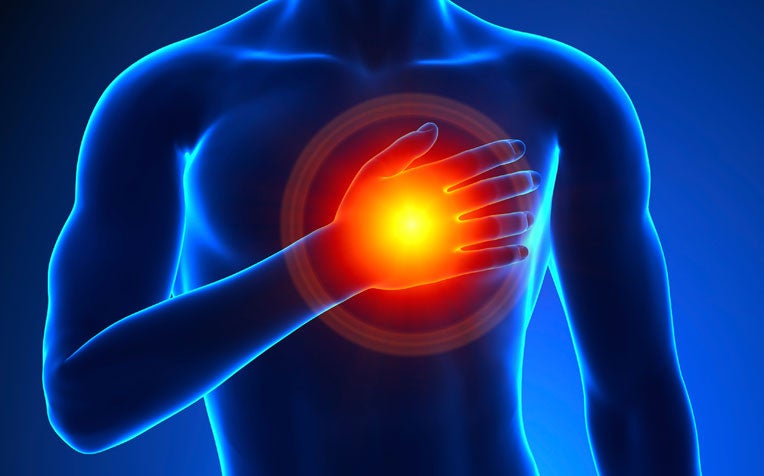
Chest pain (angina pectoris), a common symptom of coronary artery disease, may be difficult to distinguish from other types of chest pains such as indigestion.
Angina pectoris, or simply angina, is commonly known as chest pain.
Angina is one of the most common symptoms of coronary artery disease (heart disease) and is sometimes difficult to distinguish from other types of chest pain, such as discomfort from indigestion.
“Angina (angina pectoris) is a type of chest pain typically described as a squeezing sensation, pressure, heaviness or tightness in the chest,” says Clinical Assistant Professor Fam Jiang Ming, Senior Consultant, Department of Cardiology, National Heart Centre Singapore (NHCS), a member of the SingHealth group.
He adds, “If the pain can be felt in the shoulders, arms, neck, or back, and is accompanied by sweating, shortness of breath and nausea, you should seek emergency help immediately.”
Treatment for chest pain (angina)
Treatment of angina (angina pectoris) varies according to the severity of the condition. In most cases where patients suffer from mild angina, a combination of lifestyle changes and medication can help control symptoms.
Lifestyle changes often include:
Eating a healthy diet
Lowering cholesterol levels
Regular exercise,
Quitting smoking (if the patient is a smoker), as well as
Controlling diabetes and high blood pressure.
Medicine used to treat angina work either by increasing the amount of oxygen delivered to the heart or reducing the heart’s need for oxygen.
4 Common prescribed medicines to treat chest pain (angina)
1. Nitrates
Nitrates can prevent angina attacks and also relieve symptoms of angina. They work by relaxing blood vessels to the heart, thus increasing blood and oxygen supply.
Examples of nitrates are isosorbide dinitrate (tablets) and glyceryl trinitrate, also called GTN (sublingual tablets or transdermal patch).
Potential side effects of nitrates:
Flushing (redness of the skin)
Dizziness, fainting spells, rapid heartbeats
Headaches
Reddening, itching or burning sensation (where the GTN patch was applied)
These side effects tend to be temporary. A painkiller or paracetamol can be taken to relieve the headaches. Contact your doctor if symptoms persist.
2. Beta blockers
Besides preventing chest pain, beta blockers are also commonly used in the long term treatment of heart attack patients. According to Prof Fam, they help reduce workload of the heart by “lowering heart rate and blood pressure.”
Examples of beta blockers are acebutolol, atenolol, bisoprolol, carvedilol, metoprolol, nebivolol and propranolol.
Potential side effects of beta blockers:
Dizziness
Tiredness
Sleep disturbances such as insomnia and vivid dreams
Numbness or a tingling sensation in the fingers and toes
Shortness of breath, fainting spells and male impotence are all possible symptoms associated with the use of beta blockers. If you experience any of them, consult your doctor.
3. Calcium channel blockers
Calcium channel blockers control chest pain by relaxing blood vessels to increase blood supply to the heart, while slowing down heart rate. Apart from preventing angina, they can be used to treat high blood pressure and irregular heartbeats.
Examples of calcium channel blockers are amlodipine, diltiazem, nifedipine and verapamil.
Potential side effects of calcium channel blockers:
Dizziness
Feeling lightheaded
Headaches
Leg swelling
Flushing (redness of the skin)
Constipation
Symptoms such as frequent or more severe chest pain, rapid pounding or irregular heartbeats and fainting spells are considered rare, but should be highlighted to a doctor if they occur.
4. Trimetazidine
By preserving the energy metabolism of heart muscle cells, trimetazidime helps to reduce the frequency of angina attacks and reduce the use of nitrates. It is mainly used as a second line agent when the patient does not have adequate control by or develop intolerance to first line medications.
Gastrointestinal discomfort such as nausea and vomiting is a potential side effect which is usually mild.
In conclusion, medical therapy has been used effectively in the treatment of heart attack. While most patients tolerate the medications well, there is still a possibility of developing side effects to these medications. Always consult a doctor if you notice possible side effects or experience a worsening of your condition such as an increase in severity or frequency of angina as this means that your treatment may have to be adjusted.
Causes of chest pain (angina)
Angina (angina pectoris) is caused by reduced blood flow to the heart muscle. It is most often the result of coronary artery disease, where fatty deposits called plaques limit the supply of oxygen-rich blood going to your heart.
During times when oxygen demand is low, such as when you’re at rest, your heart may be able to get by on the reduced amount of blood flow. However, when there’s an increase in the demand for oxygen like during exercise, angina may set in.
Ref: I23
Contributed by















 Get it on Google Play
Get it on Google Play